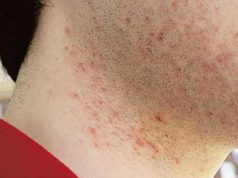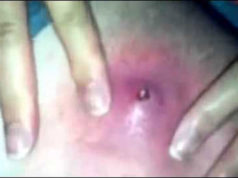Dealing with ingrown hair on buttoms can be quite a complex task. In this piece find out the possible causes of inward growing hair in buttcrack near the excretory opening, pictures, treatment, and prevention measures.
Pictures Causes & Symptoms
If you shave the hair on your seats frequently, it is most probable that you have experienced the problem of ingrown hairs more often than not. It is a painful condition that is caused by more or less the same culprits responsible for ingrown hairs elsewhere on your body. It is caused by the consequential trapping of hair under the skin.
If you shave too close to the skin surface, chances are that the cut shaft will be sharper and assume a pointed tip. It is this tip that penetrates upon curling of the shaft.
There are a variety of causal factors responsible for ingrown hairs on the butt and even leading to ingrown hair cysts such as the pilonidal cyst on the tail head close to your inter-gluteal cleft.
It is too associated with localized redness and inflammation coupled with severe pain on sitting. Fortunately, it is treatable and can be managed during its healing period using home remedies or conventional treatment medication.
Pictures

Possible Causes
One of the most heard of causes of ingrown hair in any area of your body with regard to shaving is always using the wrong technique or the right technique wrongly. Not forgetting shaving too close to the skin surface, using a blunt shaver or razor and improper aftercare treatment. Shaving buttocks is not unheard of and ingrown hairs may develop due to the following factors:
- Too close shaving – shaving too close to the skin surface may force hair shafts to curl backwards. Shaving too close also may result in cuts and abrasion making it easier for follicles to penetrate.
- Irritation – this may be caused by a fungal infection. Such infections make the skin surface itchy, dry and flaky. When the skin on this area is dry, it is easier for hair to penetrate the skin and cause damage of the cells. Some more irritation can result due to the sensitivity of the area. Sitting on herd surfaces if you have hair on your buttocks is a potential cause of ingrown hair in this area.
- Improper scrubbing of the area – it may not be easy to efficiently scrub and exfoliate this area especially the intergluteal cleft. You may also not exfoliate this area regularly making the dead skin accumulate and possibly even clog up the pores increasing the risk of ingrown hair. Accumulation of dead skin cells over a long period of time will lead to clogging of the pores through which hair follicles pass.
- Failing to use a cream or gel after shaving – using a cream enables removal of remnants hair shafts on the skin. It also reduces and prevents skin irritation after shaving so that you are not tempted to do so.
- Wearing tight clothing – this mostly applies to women since most do tight bikinis and pair of jeans. Note that you are at risk of ingrown hair in the buttocks. Especially if you do not shave, the hair in the area might be long enough to curve and curl.
- Shaving against the grain – not taking keen note on the direction of your hair growth is dangerous. Shaving against the growth direction will only make it easier to curve shafts.
- Thick body hair – having too much hair on your body doesn’t disqualify your buttocks from sharing the same. This will in fact pre-expose you to ingrown hairs not only on the buttocks but also other parts of the body.
- Being overweight and obese – obese people may have a tighter crease or deeper setting of the cleft meaning that any hair within the area will be under pressure from both butt cheeks. Apart from this, their weight leads to excessive compression of the hair in the area when they seat.
Symptoms
Ingrown hairs bear the same signs and symptoms. Some of these include:
- Pain to top of the butts or in between the butt cheeks depending on the area is specifically located.
- Fever if there is an infection
- Low back pain which might further point out to pilonidal cyst if the ingrown hair cyst was not taken care of.
- Swelling of the area around the hair follicle
- Redness or white especially if it is an infection
- Complication might lead to discharge of blood or pus upon rupturing
Ingrown Hair Removal & Treatment options
This section provides you with some tips on how to remove ingrown hairs on the butts.
Some people suggest using a multi-disciplinary approach integrating home remedies, homeopathy and natural treatment. The reason conventional medicine may not be a good idea to integrate with natural medicine is due to the possible interaction that may occur between the two. For instance, garlic may not interact well with some medications.
Further Reading:
Do this if you want to remove ingrown hair on your rear. This may be relatively harder than removing one from the intergluteal cleft.
- Prepare your tweezers or needles you will use by sterilizing them to prevent infections.
- Check the visibility of the ingrown hair. If not visible, poke the tip of the inflamed region using a needle then try pick the hair follicle and straighten it to the top. Once the hair is visible, try to pull it out without breaking it.
- If you successfully are able to remove the hair follicle, remove the clogged debris around the follicle.
- If you had contracted an infection, make sure that the discharge is drained on a ball of cotton wool and appropriate antiseptic such as Povidone-iodine applied to the area. Natural medicine suggests that to ease the inflammation, you could locally apply some turmeric with raw honey. Turmeric contains an anti-inflammatory principal known as curcumin.
- You could also apply Tea Tree Oil in 1% concentration to alleviate the pain and inflammation.
- Homeopathies suggest that low potency Hepar Sulph and Silicea in divided doses in a day keeps the infection in check[1].
How to deal with ingrown hair in intergluteal cleft
Anatomically, it is the intergluteal cleft and colloquially, the ‘but crack’. It is the groove between the butts extending from below the tail bone to the perineum. It is located above the opening through which stool comes out.
Ingrown hair can be easily removed using the following technique. Just as in the previous section,
- Sterilize your tweezers or a needles to prevent infections.
- Check the visibility of the ingrown hair. If not visible, poke the tip of the inflamed region using a needle then try pick the hair follicle and straighten it to the top. Once the hair is visible, try pull it out without breaking it.
- If you successfully are able to remove the hair follicle, remove the clogged debris around the follicle.
- If you had contracted an infection, make sure that the discharge is drained on a cotton wool and appropriate antiseptic such as Povidone iodine applied on the area.
Apart from the above procedure, check out the following;
- Deploying ‘Sitz’ baths – this involves sitting in a tub of warm water. This reduces the worsening of any cysts that may be forming.
- Fortify your diet with some vitamin C and supplements with vitamin A. the vitamins apart from boosting your immunity, helps in tissue repair.
- Apply some essential oil after you have removed the ingrown hair to soothe the area and fight infection. One such oil is tea tree oil. Castor oil may also help alleviate the inflammation around the follicle.
- A product called No Bump Rx helps prevent ingrown hairs.
- Castor oil applied to the cyst may help reduce inflammation.
- You could also use a coccyx cushion or pillow. This pillow reduces discomfort associated with ingrown hair while sitting. It further prevents formation of other ingrown hairs by providing a soft surface.
- Anti-Acne Buttocks & Thigh Treatment– Clears away acne, and ingrown hairs for the buttocks and thigh Area.
Applying garlic may be a good idea especially in infected ingrown hairs drained. However, it may be too much an irritant and benefit would not outweigh the risk and discomfort associated with topical application. Before doing anything, it would be important that you consult a doctor to advice you appropriately.
If the ingrown hair has graduated into a cyst, it would be prudent that incision and drainage procedure be performed. It uses anesthesia and is able to drain all the pus and debris inside the cavity.
Another procedure that may be used is the pit picking in which excision is not used but rather incision to drain the cyst. In this, the midline pits leading under the skin are eliminated.
References
[1] http://www.simple-remedies.com/hair-care/ingrown-hair-on-buttocks-causes.html




